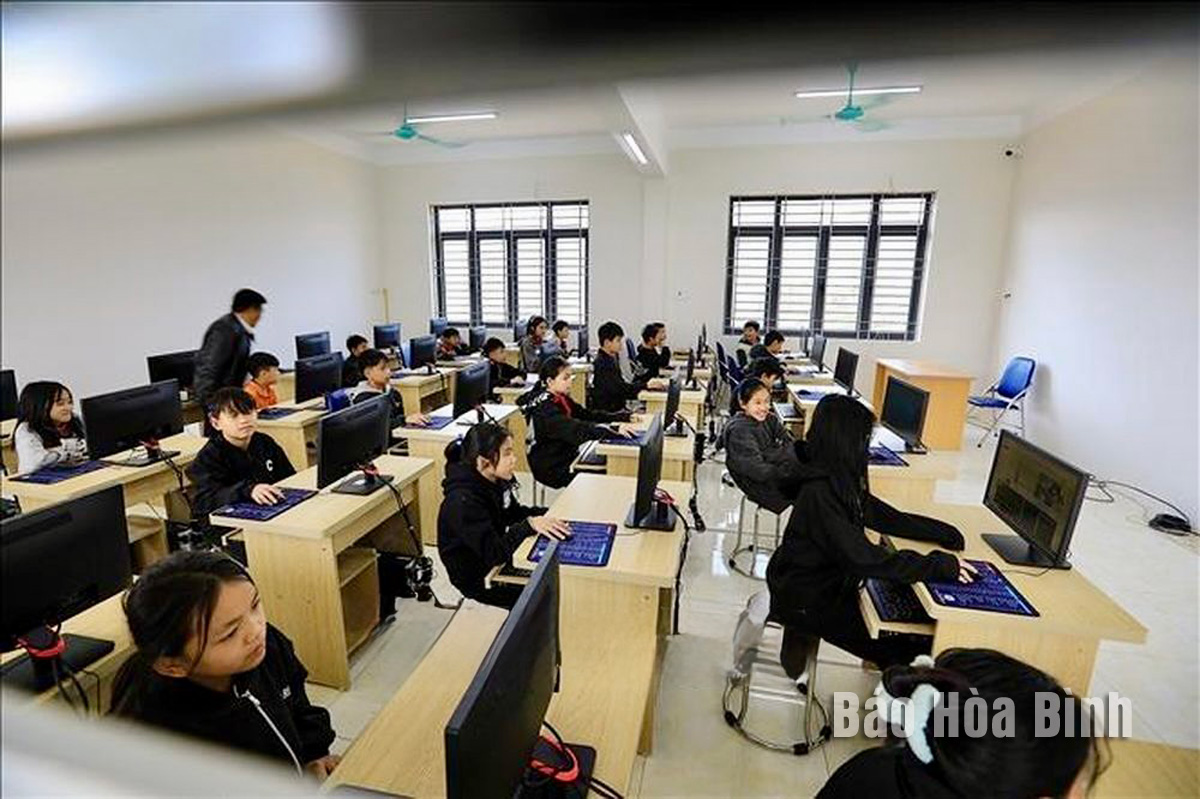
A total public investment capital of 113 billion VND (over 4.3 million USD) was disbursed for a project to upgrade infrastructure and stabilise residents in the vicinity of the Da River reservoir between 2021 and the first quarter of 2025, giving a facelift to local rural areas and improving the quality of people's life.
The Tien Phong Semi-Boarding Secondary School for
Ethnic Minority Students enjoys improved infrastructure, proving the project's
effectiveness.
Nguyen Thanh Tuan, Vice Chairman of the People's
Committee of Da Bac district, said that up to now, ten out of 11 works in the
project have been completed. The last one – the rural road in Mo Ne and Lau Bai
hamlets in Vay Nua commune – is being urgently constructed after being delayed
due to the presence of forest land, adverse weather conditions, and changes in
the compensation policy.
The project is implemented across communes, with
the office and classrooms constructed at the Tien Phong Semi-Boarding Secondary
School for Ethnic Minority Students; community learning centres built in Cao
Son, Muong Chieng, and Dong Chum communes; and irrigation systems upgraded in
Am and Moc hamlets in Nanh Nghe commune. Such works have helped local people
settle down and enhance their confidence in a bright future in new living
places.
Relocation is not just about moving people to
new places. More importantly, it is about providing them conditions to have a
safer and more sustainable life, and further develop. The infrastructure
upgrade project in the vicinity of the Da River reservoir has managed to do
that.
Each completed work marks a step towards meeting
a criterion of a new-style rural area. For examples, inter-hamlet roads help
communes meet the second criterion, the intra-field canal system is mentioned
in the third criterion on irrigation, proper schools – the fifth criterion,
houses of culture and community centres – the sixth and sixteenth criteria.
Many communes in the resettled zones such as
Tien Phong, Nanh Nghe, and Dong Chum used to struggle to develop new-style
countryside. Now, thanks to the project, the infrastructure "gaps"
have gradually been filled.
When a facility is completed, local people’s
living conditions are improved, creating a solid foundation for communes to
achieve the target on new-style rural area building.
The biggest barrier to infrastructure
improvement is forest land. Many works are located in areas planned for
forests, requiring procedures be handled to convert land use purposes. This
step is both sensitive and time-consuming. This problem caused long-lasting
delay in some works. For example, the Mo Ne - Lau Bai road in Vay Nua commune
has had its construction duration extended to 730 days from 500 days as
originally planned.
In addition, adverse weather conditions pose a
major challenge. Typhoon Yagi in 2024 damaged newly-completed roads and
prevented the transportation of equipment and machines to construction sites.
Nguyen Thanh Tuan, Vice Chairman of the People's
Committee of Da Bac district, said that facing such barriers, the locality and
construction units have persistently proposed adjustments, kept a close watch
on the actual situation, found ways to maintain progress, and made efforts to
complete construction before the rainy season.
Thanks to joint efforts, public investment
capital has been used properly, generating positive results and benefiting
local communities.
More than just an information technology teacher, Bui Van Nien is an inspiring figure who has nurtured the scientific curiosity and creative spirit of students in Vietnam’s ethnic minority communities.
Da Bac is the most disadvantaged mountainous district in Hoa Binh province, with ethnic minorities accounting for about 90% of its population. Over the past years, the district has mobilised resources to implement ethnic policies to improve the quality of life of local people.
In recent years, Hoa Binh province has consistently prioritised the protection, care, and education of children, particularly those from ethnic minorities and disadvantaged backgrounds, by creating a safe, healthy, and nurturing environment for their all-round development.
The Steering Committee for Tobacco Harm Prevention and Control of Hoa Binh province, in coordination with the Tobacco Harm Prevention and Control Fund, held a ceremony on May 28 in response to the World No Tobacco Day (May 31) and the National No Tobacco Week (from May 25 to 31). The event was chaired by Nguyen Van Toan, Standing Vice Chairman of the provincial People’s Committee and head of the Steering Committee.
Since 2021, the Center for Industrial Promotion and Industrial Development Consulting (CIIDC) under the Department of Industry and Trade has been implementing a school lighting model as part of the plan for using energy efficiently and economically in Hoa Binh Province in the pẻiod of 2021 - 2025. This model not only aims to improve the learning conditions and enhance the education quality, but it also promotes the message of energy saving, energy security, environmental protection and contributes to the goals of socio-economic development.
In the 2024 - 2025 school year, the entire Hoa Binh provincial education sector includes 520 educational institutions and schools. Among them are 13 ethnic boarding schools with 153 classes and 4,487 students. Four of these schools have met national standards, reaching 30.7 percent.



